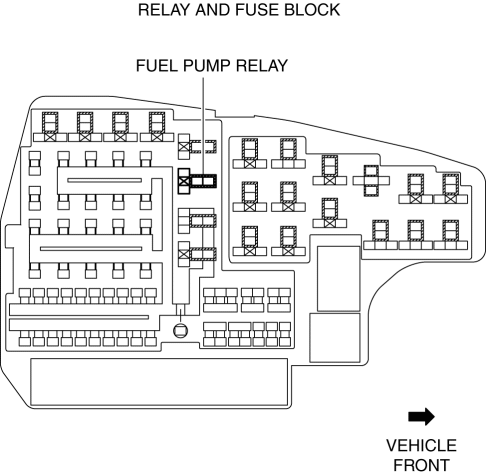Mazda CX-5 Service & Repair Manual: Before Service Precaution
WARNING:
-
Fuel vapor is hazardous. It can very easily ignite, causing serious injury and damage. Always keep sparks and flames away from fuel.
-
Fuel line spills and leakage from the pressurized fuel system are dangerous. Fuel can ignite and cause serious injury or death and damage. Fuel can also irritate skin and eyes. To prevent this, always complete the “Fuel Line Safety Procedure”.
-
A person charged with static electricity could cause a fire or explosion, resulting in death or serious injury. Before performing work on the fuel system, discharge static electricity by touching the vehicle body.
Fuel Line Safety Procedure
1. Disconnect the negative battery cable..
2. Remove the fuel-filler cap to release the pressure inside the fuel tank.
3. Remove the fuel pump relay.

4. Disconnect the high pressure fuel pump connector.
5. Connect the negative battery cable..
6. Start the engine.
7. After the engine stalls, crank the engine 2—3 times.
8. Switch the ignition to off.
9. Disconnect the negative battery cable..
10. Install the fuel pump relay.
11. Connect the high pressure fuel pump connector.
 After Service Precaution
After Service Precaution
WARNING:
Fuel line spills and leakage are dangerous. Fuel can ignite and cause serious
injuries or death and damage. When installing the fuel hose, perform “Fuel Leakage
Inspection” ...
 Check Fuel Cap Warning Light
Check Fuel Cap Warning Light
Purpose/Function
The check fuel cap warning light is built into the instrument cluster.
If the PCM detects that the fuel cap is open, the light illuminates to warn
the driver that th ...
Other materials:
Torque Converter Clutch (TCC) Control Solenoid [Fw6 A EL, Fw6 Ax EL]
Purpose/Function
The torque converter clutch (TCC) control solenoid adjusts the hydraulic
pressure in the TCC control circuit based on the current demand from the TCM
according to the vehicle conditions.
Construction
The TCC control solenoid is installed to the solenoid con ...
Automatic Transaxle Warning Light [Fw6 A EL, Fw6 Ax EL]
Purpose/Function
The automatic transaxle warning light illuminates when the transaxle has
malfunction.
Construction
The automatic transaxle warning light is built into the instrument cluster.
Operation
If the transmission has a malfunction, the TCM sends an ...
Quick Release Connector Removal/Installation
WARNING:
Fuel is very flammable liquid. If fuel spills or leaks from the pressurized
fuel system, it will cause serious injury or death and facility breakage. Fuel
can also irritate skin and eyes. To prevent this, always complete the “Fuel
Line Safety Procedure”, while referring ...
